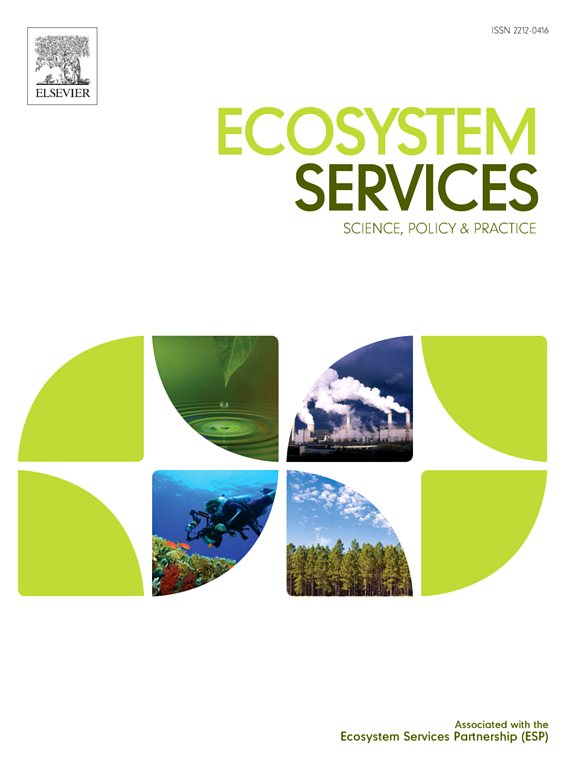海岸带湿地吸收和缓冲极端天气事件对海岸带基础设施影响的效益量化方法综述
IF 6.6
2区 环境科学与生态学
Q1 ECOLOGY
引用次数: 0
摘要
沿海湿地减少了极端天气事件对全球海岸线的影响。由于气候变化预计会增加这些事件的频率和强度,了解湿地如何吸收和缓冲极端天气事件对于促进其保护和恢复作为气候适应策略至关重要。这篇系统的文献综述检查了以前研究中使用的方法,这些方法用于量化极端天气事件对沿海湿地(红树林和潮汐沼泽)及其保护的基础设施的保护效益的影响。根据129项研究,我们将报告的对湿地的影响分类为:机械损伤(33%)、泥沙动力学(8%)和水特性(0.8%)。极端天气事件对湿地影响的减少被归类为基础设施破坏(23%)、水动力强迫(39%)或社会影响(7%)。平均而言,极端天气事件破坏了65%的红树林和8%的潮汐沼泽。沿海湿地降低了46%±27%的浪高和47%±15%的沿海洪水,减少了60%的基础设施破坏。用于量化影响的方法包括:空间模型(25%)、基于实地的方法(28%)、变化分析(19%)、线性模型(10%)、非线性回归(7.8%)、经济评估(4%)、指数开发(4%)和贝叶斯网络模型(2.3%)。选择最佳方法取决于影响类型、数据可用性、资金和规模,并在准确性、成本效益和范围之间进行权衡。我们将讨论这些权衡如何为未来的调查提供信息,以及为财产和自然保险提供可靠方法的含义。未来的研究应沿着环境梯度评估影响的变化,并探索湿地如何调节极端天气事件的社会文化后果。本文章由计算机程序翻译,如有差异,请以英文原文为准。

Review of methods for quantifying the benefits of coastal wetlands in absorbing and buffering extreme weather event impacts on coastal infrastructure
Coastal wetlands reduce extreme weather event impacts on coastlines globally. As climate change is expected to increase the frequency and intensity of these events, understanding how wetlands absorb and buffer extreme weather events is essential for promoting their conservation and restoration as a climate adaptation strategy. This systematic literature review examines methods used in previous research to quantify impacts of extreme weather events on the protective benefit of coastal wetlands (mangroves and tidal marshes) and the infrastructure they protect. Drawing from 129 studies, we categorise reported impacts on wetlands as: mechanical damage (33%), sediment dynamics (8%), and water properties (0.8%). Reductions in extreme weather event impacts by wetlands were categorised as infrastructure damage (23%), hydrodynamic forcing (39%), or social impacts (7%). On average, extreme weather events damaged 65% of mangroves and 8% tidal marshes. Coastal wetlands reduced wave height by 46% ± 27% and coastal flooding by 47% ± 15%, reducing infrastructure damage by up to 60%. Methodologies used to quantify impacts included: spatial models (25%), field-based approaches (28%), change analyses (19%), linear models (10%), non-linear regression (7.8%), economic valuation (4%), index development (4%), and Bayesian network models (2.3%). Choosing the best method depends on impact types, data availability, funding, and scale, with trade-offs between accuracy, cost-effectiveness, and scope. We discuss how these trade-offs may inform future investigations and the implications of robust methodologies for insuring properties and nature. Future research should assess variation in impacts along environmental gradients and explore how wetlands regulate socio-cultural consequences of extreme weather events.
求助全文
通过发布文献求助,成功后即可免费获取论文全文。
去求助
来源期刊

Ecosystem Services
ECOLOGYENVIRONMENTAL SCIENCES&-ENVIRONMENTAL SCIENCES
CiteScore
14.90
自引率
7.90%
发文量
109
期刊介绍:
Ecosystem Services is an international, interdisciplinary journal that is associated with the Ecosystem Services Partnership (ESP). The journal is dedicated to exploring the science, policy, and practice related to ecosystem services, which are the various ways in which ecosystems contribute to human well-being, both directly and indirectly.
Ecosystem Services contributes to the broader goal of ensuring that the benefits of ecosystems are recognized, valued, and sustainably managed for the well-being of current and future generations. The journal serves as a platform for scholars, practitioners, policymakers, and other stakeholders to share their findings and insights, fostering collaboration and innovation in the field of ecosystem services.
 求助内容:
求助内容: 应助结果提醒方式:
应助结果提醒方式:


